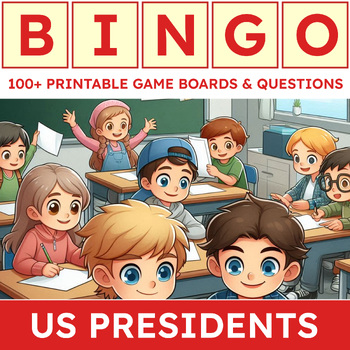BINGO: US Presidents (100+ printable boards, caller's sheets, and markers)
- Zip
What educators are saying
Description
PRINT AND PLAY!
- Print as many unique game boards as you want (up to 100).
- Print and cut as many markers as you'd like, or use pieces of paper, supplies, dobbers, markers, or chips.
- Use the provided questions sheet to play multiple unique games. Ask one question, or ask many to help your students along.
- This set will play multiple unique games! It contains 100 bingo boards and over 400 questions (over 10 each per president) to ask your students.
- Play short, long, or unique games.
- A rule guide is provided, but sometimes it's fun to make your own!
This BINGO game questions players on their knowledge of US Presidents. The back includes 100 boards, printable chips, a few sets of caller cards with varied questions, and instructions. Print what you need and play! No further preparation required! Laminate your games for future use.
Get Ready to Learn and Play with SuperSheets Educational Bingo!
Unleash the excitement of learning through play! This engaging educational game challenges players' knowledge while they enjoy the thrill of the classic bingo experience.
Use this as:
- a way to introduce a topic
- reinforce ideas taught in class
- review for the end of a unit
- a fun way to unwind
How to Play:
Set Up:
- Unpack your game kit which includes printable bingo boards, chips, and a caller's card with intriguing questions.
- Print out the desired number of bingo boards based on your group size.
- Arrange the boards, chips, and calling card in a convenient spot for all players.
Game Play:
- Designate an announcer to read out questions from the calling card and mark them off as they're announced.
- Distribute a bingo board and chips to each player.
- Explain the win conditions: players aim to make a line, four corners, or cover every space on their board.
- As the announcer randomly selects questions, players mark the corresponding answers on their boards.
- The first player to meet the win conditions shouts "Bingo!"
Winning and Continuing Play:
- Verify the winner's answers on their bingo board for accuracy.
- Offer a prize or reward to celebrate the winner's victory.
- Reset the game for the next round, or continue until all players have had a chance to win.
Maintenance and Storage:
- After each use, store the game components safely and securely.
- Consider laminating the bingo boards for future use.
- Store the game kit in a dry and secure location until the next play session.
Additional Tips:
- Customize questions to suit the educational needs and interests of your players.
- Encourage collaboration and teamwork to enhance engagement.
- Adapt the game difficulty based on the age and skill level of the players.
Here's a little preview of what to expect:
This president was known for his inventions, such as the revolving bookstand and polygraph.
Do you know who it is? Mark it on your board!
Or if not, here are some more clues:
He authored the Declaration of Independence.
He founded the University of Virginia
He doubled the size o the United States with a significant land acquisition.
He was the third president of the United States.
That's Thomas Jefferson! Mark it if you have it on your board!




